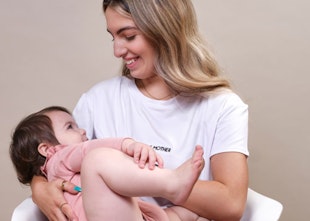The onset of teething can be a drooling time for everyone involved but the thing is, there is no strict list of symptoms for any one child.
Every baby is different, especially when it comes to teething - some babies don't show noticeable signs of tooth eruption while others go through them all at once.
It's potluck really.
For example, some would say my babies teeth quite young. In fact, my three youngest all had their bottom two teeth at four and five months old. One baby was irritable, drooled bucket loads and didn't sleep anywhere but my chest while my now six-month-old daughter showed no major symptoms other than trying to chomp and chew on everything in sight.
A majority of children will develop teeth between six and twelve months and the lower central incisors are almost always the first teeth to cut through the gum line, followed by the top central incisors.
Signs and symptoms of teething:
If you notice one or more of these symptoms together, there is a high possibility your baby is teething but remember, there is always a chance it could be something else. If you are ever in doubt, consult with your GP.
A majority of children will develop teeth between six and twelve months and the lower central incisors are almost always the first teeth to cut through the gum line, followed by the top central incisors.
Difficulty sleeping.
Due to the discomfort from the swelling and soreness, your baby may find it hard to sleep at night and during naptime but rest assured, once the tooth has popped out your little one will most likely fall back into their old sleep routine - that's if they had one to begin with!
Lack of appetite.
Breastfeeding or sucking on a bottle can sometimes irritate sore gums which can lead to a nursing strike. If you are concerned your baby is not staying hydrated, consult with your GP.
Trying to chew, suck and bite on everything.
If you notice your child is trying to gnaw and chew on their fist, clothes or toys, they may be trying to relieve pressure on their gums caused by the movement of the tooth.
Irritability and fussiness.
Cutting teeth can be painful so if your baby is otherwise healthy, crankiness can be a sign that a tooth is pushing its way through the gum line. Some babies can be more fretful than usual and will want to be close to you, this is completely normal.

Excessive drooling.
Drooling is one of the most common ways to tell if a baby is teething. To help prevent skin irritation and wet soggy clothing, use soft cotton bibs around babies, changing them regularly.
Severe drooling can sometimes cause a rash around the mouth, chin and sometimes across babies' chest due to the extra moisture. Gently wipe away saliva and use a barrier cream to protect your baby's skin.
Rubbing or pulling face and/or ears.
For babies, teething can be very confusing and considering the nerves in the jaw, ears, cheek and gums are all connected, pain can be transferred to other parts of the body.
So if you notice them pulling and tugging at their face, it could be an obvious sign they are cutting a tooth.
Red or flushed cheeks.
Another common telltale sign that a tooth is about to emerge is visibly red cheeks and you may also notice your baby's cheeks feel warmer than normal.
To soothe your teething infant, try massaging sore gums with clean fingers, offering cooled teething rings and a wet or frozen washcloth to help ease any pain.
Another common telltale sign that a tooth is about to emerge is visibly red cheeks and you may also notice your baby's cheeks feel warmer than normal.
If your baby is still in discomfort, sugar-free teething gels are available over the counter from pharmacies nationwide which contain a mild local anaesthetic which can help numb any pain.
If symptoms persist, your pharmacist may recommend a sugar-free pain relief such as paracetamol or ibuprofen medication.
The HSE advises against the use of amber teething necklaces, anklets and bracelets. They pose a high choking risk, regardless of how they are used. They also warn against the use of unlicensed homoeopathic products sold online.
Teething can be a rough time for both parent and baby but remember, it is just a phase and your normal routine should fall back into place once the tooth has made an appearance.







